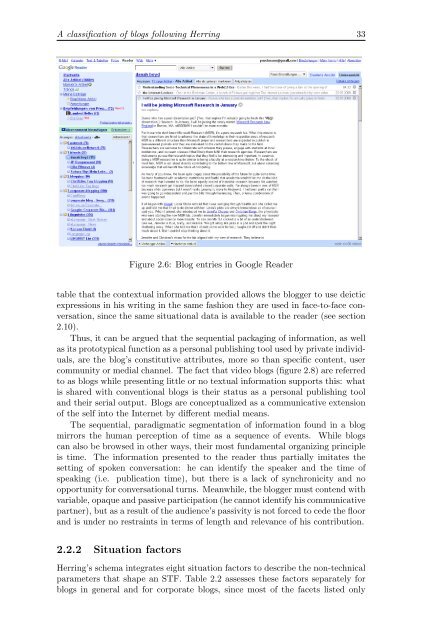The corporate blog as an emerging genre of computer ... - Oapen
The corporate blog as an emerging genre of computer ... - Oapen
The corporate blog as an emerging genre of computer ... - Oapen
You also want an ePaper? Increase the reach of your titles
YUMPU automatically turns print PDFs into web optimized ePapers that Google loves.
A cl<strong>as</strong>sification <strong>of</strong> <strong>blog</strong>s following Herring 33<br />
Figure 2.6: Blog entries in Google Reader<br />
table that the contextual information provided allows the <strong>blog</strong>ger to use deictic<br />
expressions in his writing in the same f<strong>as</strong>hion they are used in face-to-face conversation,<br />
since the same situational data is available to the reader (see section<br />
2.10).<br />
Thus, it c<strong>an</strong> be argued that the sequential packaging <strong>of</strong> information, <strong>as</strong> well<br />
<strong>as</strong> its prototypical function <strong>as</strong> a personal publishing tool used by private individuals,<br />
are the <strong>blog</strong>’s constitutive attributes, more so th<strong>an</strong> specific content, user<br />
community or medial ch<strong>an</strong>nel. <strong>The</strong> fact that video <strong>blog</strong>s (figure 2.8) are referred<br />
to <strong>as</strong> <strong>blog</strong>s while presenting little or no textual information supports this: what<br />
is shared with conventional <strong>blog</strong>s is their status <strong>as</strong> a personal publishing tool<br />
<strong>an</strong>d their serial output. Blogs are conceptualized <strong>as</strong> a communicative extension<br />
<strong>of</strong> the self into the Internet by different medial me<strong>an</strong>s.<br />
<strong>The</strong> sequential, paradigmatic segmentation <strong>of</strong> information found in a <strong>blog</strong><br />
mirrors the hum<strong>an</strong> perception <strong>of</strong> time <strong>as</strong> a sequence <strong>of</strong> events. While <strong>blog</strong>s<br />
c<strong>an</strong> also be browsed in other ways, their most fundamental org<strong>an</strong>izing principle<br />
is time. <strong>The</strong> information presented to the reader thus partially imitates the<br />
setting <strong>of</strong> spoken conversation: he c<strong>an</strong> identify the speaker <strong>an</strong>d the time <strong>of</strong><br />
speaking (i.e. publication time), but there is a lack <strong>of</strong> synchronicity <strong>an</strong>d no<br />
opportunity for conversational turns. Me<strong>an</strong>while, the <strong>blog</strong>ger must contend with<br />
variable, opaque <strong>an</strong>d p<strong>as</strong>sive participation (he c<strong>an</strong>not identify his communicative<br />
partner), but <strong>as</strong> a result <strong>of</strong> the audience’s p<strong>as</strong>sivity is not forced to cede the floor<br />
<strong>an</strong>d is under no restraints in terms <strong>of</strong> length <strong>an</strong>d relev<strong>an</strong>ce <strong>of</strong> his contribution.<br />
2.2.2 Situation factors<br />
Herring’s schema integrates eight situation factors to describe the non-technical<br />
parameters that shape <strong>an</strong> STF. Table 2.2 <strong>as</strong>sesses these factors separately for<br />
<strong>blog</strong>s in general <strong>an</strong>d for <strong>corporate</strong> <strong>blog</strong>s, since most <strong>of</strong> the facets listed only


